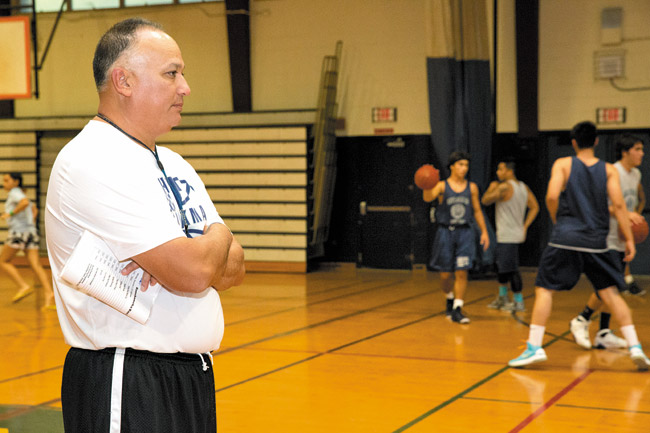Prep Hoops Need A Shot Clock

New Kamehameha coach Greg Tacon is an advocate of a shot clock for high school games | Leah Friel photo
As the local high school basketball season gets
under way, conversation among prep hoop fans invariably will get around to whether or not a shot clock should be a necessity. The national high school federation doesn’t make the use of a shot clock mandatory; instead, they leave it up to local state associations. Hawaii’s coaches and athletic directors have talked about the subject many times, but nothing changes locally.
That’s an injustice to the game.
Local fans remember the 15-13 stall-ball contest a year ago between Iolani and Mary-knoll. And that’s not the only time we’ve shuddered at the sight of a player standing at midcourt with neither offense nor defense making a move. Often, you’ll see a team run its offense for several minutes without shooting in an effort to protect its lead.
“I understand the strategy behind it,” says Greg Tacon, now the head coach at Kamehameha after previous stints at Moanalua and Punahou. “A shot clock would not only speed up the game, but it rewards good defense. It also probably would lead to more pressure defense and less zone.”
A couple of years ago, Tacon became involved in an effort to show the strength of the shot clock.
“It started when Dr. Peter Caldwell donated a shot clock to Moanalua and we put it to use for our Christmas tournament,” Tacon recalls.
Caldwell is a local sports enthusiast, a publisher and photographer for scoringlive.com whose son Tahi played for the Menehune.
“Last night, while taking photos, I was reminded again about the effect of not having a shot clock, as (our team) had a nice lead and just ran clock for about four to five minutes. It’s entirely within the rules, but we see this strategy frequently and in the state tournament especially. It detracts from the game and is not favored by players and fans alike.
“We put in a 35-second shot clock and it worked very well,” Tacon says. “The Christmas tournament went away, so now we use it for the OIA-ILH Challenge.”
Tacon’s Kamehameha Warriors will join ILH brothers Punahou, Maryknoll and Saint Louis, along with OIA rivals Farrington, Kalani, Kahuku and the host Menehune in a three-day boys varsity tournament this week, Dec. 11-13, at Moanalua High’s gym. The shot clock will be used for all games. (Scheduled contests pitting ILH teams against OIA teams are at 4, 5:30, 7 and 8:30 p.m. each day.)
Despite these grassroots efforts to showcase the shot clock, Tacon isn’t expecting a change anytime soon.
“Personally, I think it’s an impossibility,” he says. “Coaches want it, but you’ve got to get all the athletic directors on board and, unfortunately, that’s not the case.”
The naysayers point to tight budgets and the costs of purchasing shot clocks, as well as paying someone to operate it.
The shot clock’s biggest advocate, Caldwell, says the equipment is getting cheaper, so he hopes that barrier can be broken soon.
“Currently, the cost of a good wireless portable system has come down to the $600-$700 range,” he says. “Eight states now use shot clocks (California, Maryland, Massachusetts, New York, North and South Dakota, Rhode Island and Washington). At the annual Iolani Classic, visiting teams often comment in surprise that there is no shot clock here.”
Perhaps with successful efforts like the tournament at Moanalua, minds will change, purses will open and a necessary idea can move forward. Your support of the OIA-ILH Challenge will go a long way in making it eventually become reality.
senatorbobhogue@ yahoo.com





